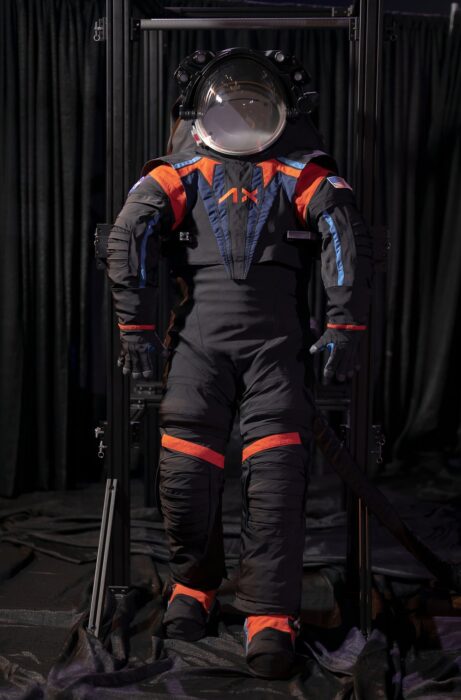Mar 16 2023
Moon Spacesuit Prototype Unveiled
 Good spacesuits are deceptively difficult to design, even with today’s technology. NASA is planning to return to the moon in 2025 (if all goes well) but the spacesuit the astronauts will wear is one piece to the puzzle they have not completed yet (the other being the lunar lander). In fact, NASA spent $420 million on spacesuit development but was unhappy with the results. They therefore contracted out the design to private industry. Axiom space won a $228 million contract and just unveiled their first prototype.
Good spacesuits are deceptively difficult to design, even with today’s technology. NASA is planning to return to the moon in 2025 (if all goes well) but the spacesuit the astronauts will wear is one piece to the puzzle they have not completed yet (the other being the lunar lander). In fact, NASA spent $420 million on spacesuit development but was unhappy with the results. They therefore contracted out the design to private industry. Axiom space won a $228 million contract and just unveiled their first prototype.
It might seem that we are reinventing the wheel, as NASA already developed spacesuits for moon landings – 50 years ago. Couldn’t they just tweak or update those designs? What about the spacesuits they have been using on the ISS?
The Apollo spacesuits, while iconic, were limited. One of the big challenges is creating a suit that can maintain internal pressure without overly limiting movement. A pressurized suit is extremely limiting. The suit obviously has to be tough enough to maintain pressure, without leaking any air. It also has to maintain temperature, through extremes. On the moon, without an atmosphere, the temperature varies from 120 C to -130 C. The moon is also a harsh environment. The regolith is like microscopic glass shards, and was brutal to the Apollo suits. Getting into mechanical joints could freeze them, and the abrasive action can degrade suits. For these reasons the Apollo suits were only rated for 115 hours of pressurized use. They were one-offs, built custom for each astronaut and intended for only a single use.
The more modern suits used for EVA from the ISS have their own problems. They are not designed for the lunar surface. They also have had issues with having sufficient sizes to accommodate a diverse astronaut corp. So the bottom line is that NASA needed to design an entirely new spacesuit for their planned lunar missions. They unveiled a prototype in 2019, but were ultimately unhappy with the results and wanted to hedge their bets. Now we have another design from Axiom Space.
The Axiom suit, which is mostly black (interesting choice) does look less cumbersome than the NASA design. The joints are designed to enhance mobility. The suits are designed to fit a wide range of astronauts. They have multiple redundancies to limit failure, and are engineered to take the harsh regolith of the moon. The helmet offers a wider range of vision than the NASA helmets. They also incorporate their own lighting and HD cameras. I am looking forward to some modern high definition footage of the moon. 
This was a good move by NASA. What they are doing is partnering with private industry for what they call “moonwalking services”. In addition to their contract with Axiom, they are also contracting with Collins Aerospace for moonwalking services, this way they have two options and this sets up some friendly competition to provide better service. Also, the NASA contract allows them to use any knowledge that results from the use of these spacesuits on NASA missions, for their own later purposes. These suits are also designed for “multiple destinations” and are multi-purpose. I think this means they can also be used for EVA, but there is also the suggestion that they could be used for any future Mars missions.
I am glad to see Axiom get a lucrative contract from NASA and produce what appears to be a solid product. They are perhaps one of the leading private companies trying to develop commercial space. They are planning the first commercial space station, which will essentially be the successor to the ISS. They are already constructing components and plan their first launch in late 2025.
This seems to be the sweet spot for further developing space – private industry essentially does all the design and implementation. They are funded, at least for now, primarily by fulfilling NASA contracts, but this sets them up to develop purely commercial applications. NASA, meanwhile, steps back from engineering. They provide missions, funding, oversight and standards. It’s a good relationship that seems to be working – much more than the old way of NASA operating like a general contractor. While the space launch system, for example, is impressive, and it seems it will get us back to the moon, it is extremely expensive and was delayed by years. Each mission costs a billion dollars and no component is reusable. Compare this to SpaceX which has been focusing on reducing the cost of getting things into space, and is trying to maximize reusability.
This latest spacesuit is another example. NASA tried to do it itself, and was unhappy with the results. Axiom came up with what appears to be a superior design for half as much and in just a year. I do suspect they were already working on their own spacesuit design prior to getting the NASA contract, to support their own commercial space station. Even still, and in hindsight, NASA just should have outsourced their new spacesuit from the beginning.
This is also a good model for public-private partnerships in general. Each sector has its own strengths and weaknesses, and finding a way to leverage the strengths of each while compensating for the weakness can make for a very effective combination.






